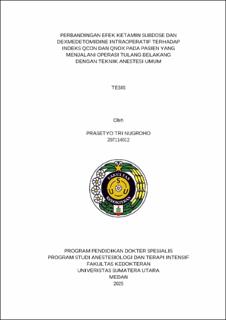| dc.description.abstract | Background: Assessment of consciousness and nociception during general
anesthesia is crucial for maintaining hemodynamic stability and avoiding over- or
under-sedation. qCON and qNOX indices, derived from electroencephalography
(EEG), are useful parameters for real-time monitoring of the patient's level of
consciousness and pain response. Ketamine and dexmedetomidine, as anesthetic
adjuvants, have distinct mechanisms in modulating consciousness and
nociception.
Objective: To compare the intraoperative effects of subdose ketamine and
dexmedetomidine on qCON and qNOX indices in patients undergoing spinal
surgery under general anesthesia.
Methods: This was a randomized clinical trial involving 42 patients undergoing
spinal surgery. Subjects were divided into two groups: ketamine and
dexmedetomidine. Parameters measured included qCON and qNOX values at five
time points (pre-induction, intubation, incision, 2 hours post-incision, and
extubation), total intraoperative fentanyl and sevoflurane requirements, and pain
score (NRS) two hours postoperatively. Data were analyzed using the Mann-
Whitney test and repeated measures ANOVA with a significance level of p<0.05.
Results: There were significant differences in qCON and qNOX values between
the two groups at several time points. No significant differences were observed in
fentanyl requirement, mean sevoflurane concentration, or NRS scores two hours
postoperatively (p>0.05).
Conclusion: Subdose ketamine and dexmedetomidine showed different effects on
qCON and qNOX indices, reflecting differences in anesthetic depth and pain
perception. qCON values were lower in the dexmedetomidine group during
intubation, incision, and extubation. Conversely, qNOX values were lower in the
ketamine group at intubation, incision, and 2 hours post-incision. | en_US |


